Contents
ALTERNATIVE FUELS IN THE CEMENT INDUSTRY
[wpecpp name=”package + Updates forever” price=”250″ align=”center”]
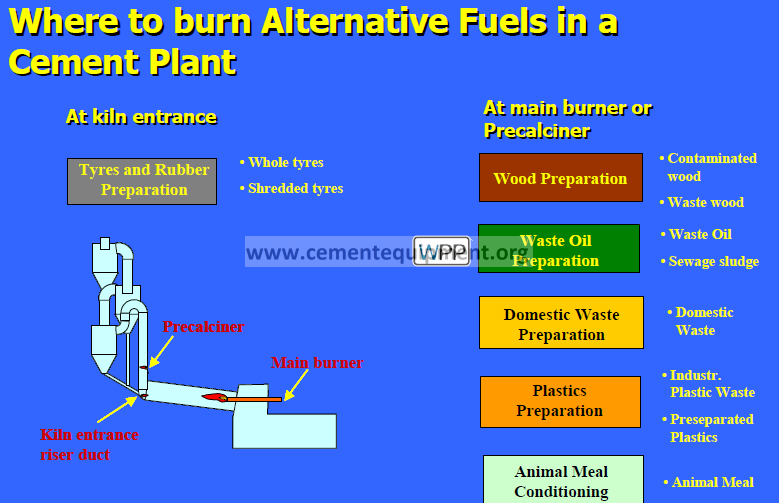
1 INTRODUCTION
The production of Portland cement requires a high degree of thermal energy. Burning of 1kg PZ-Clinker out of raw material components limestone and clay requires 1,75 MJ thermal energy in basic calculation.
This requirement is based on endothermal reactions of Decarbonisation of limestone and dehydration of the Kaolinits (a value of approx. 2,20 MJ/kg) and exothermal reaction of phase forming (C35, C23, C3A and C4AF (value approx. –0,45 MJ/kg).
The effective requirement of thermal energy is approx. 3.2-6 MJ/kg depending on the process.
The dry-process value is split to approx. 50% for chemical reaction and approx. 50% in radiation loss (approx. 10-12%) exhaust air (about 10%) exhaust gas (up to 20%) and clinker (approx. 2%).
The heat recuperation is from the exhaust air through the drying of raw material, coke, blast furnace slag, etc. The combustion efficiency can achieve 80%.
For production of serviceable PZ-Clinker, fuel has to be put in oxidizing atmosphere to approx. 1450° C (sintering). Therefore a minimum temperature of some 1800°C at 3% Oxygen O2 content is required. Practically the exhaust gas temperature should be at 2000° C .
At a secondary air temperature of lower than 800° C a calorific value of minimum of 13 MJ/kg fuel would be pertinent to the above mentioned case.. To secure a continuously running operation the calorific value should not undergo the limit of 18 MJ/kg fuel.
At secondary combustion the calorific value could be below 10 MJ/kg.
The standard used fuels in cement industry are gas, furnace oil, miscellaneous coals and pet-coke. The used raw meal mix can be mixed with ash in addition.
Due to common combustion of high valued fuel (flammability due to volatile components) with low-valued alternative fuel, the required calorific values can be achieved. Depending on the type of alternative fuel used, a substitution up to 80% can be achieved – in some case up to 100%.
Due to the use of alternative fuel in the clinker production the cement industry takes some important disposal functions at the same high economical stakes.
The claim of waste industry about destroying of detrimental organic substances in controlled processes as well as the avoidance of detrimental residue (ash, slag) due to the storage of heavy metal in clinker components in the lowest, most innocuous concentration will be fully covered.
Emphasizing Advantages by using Alternative Fuels:
1. Reduction of CO2- Emissions (Kyoto-target):
– Dumping of thermal utilizing waste the active greenhouse effect will occur
– By combustion in combustion plant additional CO2 emission occurs.
2. Cost reduction of PZ-Clinker production due to using inexpensive fuel.
3. Preservation of resources – lower use of fossil nonrenewable fuel
4. Reasonable secondary use of material
5. Residue free combustion – due to not existing ash, soil and sewage
6. No significant change of emissions
7. Hazardous substances will be destroyed due to the process – high temperature level, long gas residue time, alcalic combustion material, counter flow principle and oxidizing atmosphere
8. High thermal efficiency
9. Fulfillment of substantial dump disposal
10. High yielding ecological balance
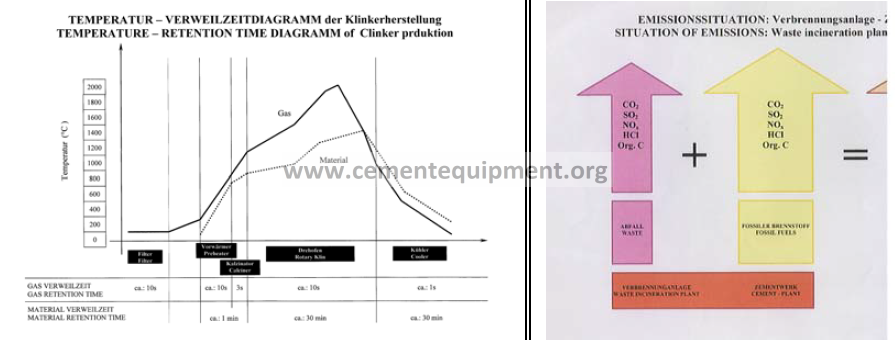
2 IMPORTANT FUELS IN THE CEMENT INDUSTRY
Alternative fuels consist mainly 3 components, their parts can occur differently.
– water – as moisture
– organic components
– mineral components – responsible for the ash content
The following schedule shows currently used and most conventional alternative fuels in European Cement Industry.
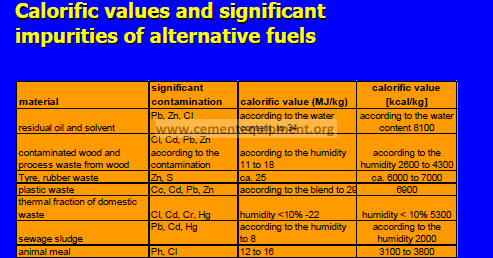
In that schedule the possible contamination is shown by different elements, potential moisture content and the calorific values.
The properties of the elements at feeding as combustion fuel in the kiln system has to be evaluated depending on the level of contamination. The question is, which transfer and in which form and value could that be done?
Typical properties of the elements:

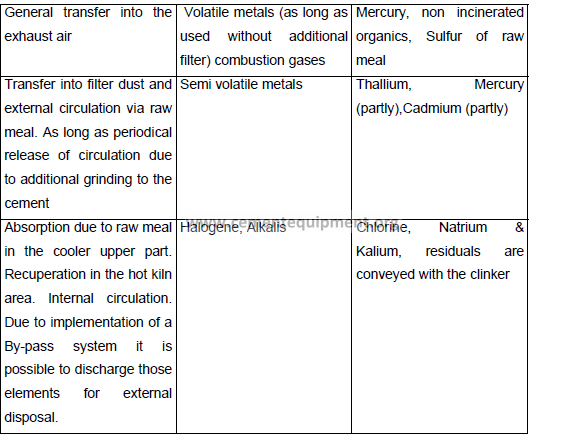
In some case it is possible to compare some analysis of the used combustion fuel to the used alternative fuel and raw meal – which has a lot bigger mass flow (raw meal/fuel = approximately 16:1) – to give a ballpark figure about reaction.
3 PREPARATION AND CONDITIONING OF ALTERNATIVE FUELS
For operation and combustion process some important criteria have to be deemed for conditioning.
Production of even PZ-Clinker requires a constant and complete combustion of the used fuel. The oxidation of C and H runs any quicker if the intimate mix of fuels and the specific surface is larger – that means to assure- especially in the case of liquid fuel where the spraying- in has to be as smooth as possible, vs. solid fuels on intimate mixture with other fuels used at the same time – the biggest possible surface due to perfect conditioning (low particle size).
Further significant points for the conditioning process especially for consistent alternative fuels are:
1. even particle distribution
2. as even as high calorific value
3. Free of affecting contents like metals, glass, minerals
4. low moisture
This technical combustion requirements regard special preparation conditions for consistent alternative fuels, which are given due the different components. Especially it is to take care about separation of non-burning fuels as metals, glass, mineral fraction etc.
It is pertinent to check up on organic contamination, because a rottenness process can occur – potentially in combination with moisture, which can cause a reaction of bacteria and nucleus. Another criterion for the conditioning plant is the regarded hygienic and security condition for the operating personnel.
A very important point of the conditioning is the relation between economic efficiency and reasonable combustion particle size. Frankly, lowering the particle size causes an increase of
conditioning costs. The most favorable particle size for combustion depends on the alternative fuel dosing, dosing bulk and scope of application for processing. Either depending on the mode of operation. It should be determined in common to the burning technology.
PMT-Zyklontechnik GmbH has come to know how to meet and match the requirements for conditioning of alternative fuels in cement industry, developed according to the type of fuel the required technology and equipment. The conditioning functionality at all operation is running mechanically and under ruled hygienic conditions .
3.1 WPP-OPERATION
In WPP- operation (Wood-preparation-Process) contaminated wood is separated of affecting contents and crushed -. depending on the scope of application in clinker processing in accordance to the particle size (primary- and secondary combustion).
For using at primary conveying, a particle size of 6mm has shown as optimal size for combustion.
3.2 TPP-OPERATION
The TPP-operation (Tire-Preparation-Process) is designed for crushing of plastic, tires and plastic-like materials and plastic, as for separation of whole tires and the gravimetric dosing
of that material to the kiln system too.
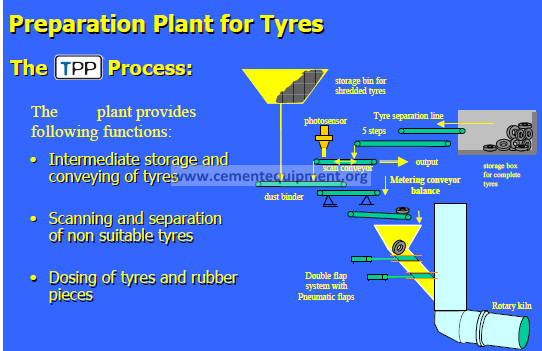
3.3 PPP-OPERATION
The PPP-operation (Plastic-Preparation-Process)
This processing is to prepare of all types of plastic, textiles, paper, composite materials, etc. contaminated with metal, glass, and minerals – mechanically fully separated and prepared to fuel
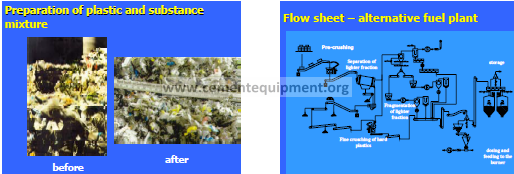
For the use in primary combustion, the particle size of 10 mm edge length has shown to be optimal for higher dosing rates Preparation mixturePreparation of plastic and substance mixturebeforeafterFlow plantFlow sheet –alternative fuel plantFine crusching of hard plasticsdosingand feeding to the burnerstorageFragmentationof lighter fractionSeparation of lighter fractionPre-crushing
Combustion of bigger sized plastic material performs at entrance into the high temperature area of the flame a ball-shaped profile instantly, due to the material structure. (decreasing of surface). The reason is to avoid a too fast burn-off – jeopardy of burning out at the clinker bed – creating of reducing condition).
The best and most economical solution to produce particles with a size of about 10mm is the use of high speed crushers. Disturbance variables have to be avoided. Pmt-Zyklontechnik GmbH has developed a special processing for this purpose.
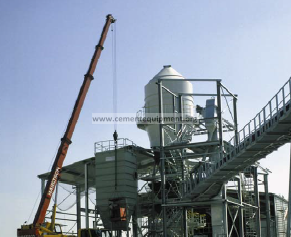
3.4 MTP-OPERATION
The MTP-operation (Mechanical-Thermal-Process)
is a patented process for separation of high energy components (plastic, paper, textiles, organic material etc.) moisture and highly affecting components as metals, glass and mineral materials.
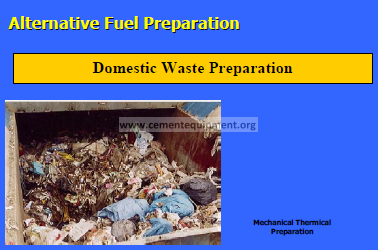
That process provides stable operation with the above mentioned material, additional some increase of bacteria and nucleus is prevented. Either no emission loss in this process. The thermal fraction is used in the PPP-process. The process was tested in order to research and develop all pertinent measuring concerning affecting emission and vitiation.
This type of process provided fuels containing a calorific value of more than 20 MJ/kg
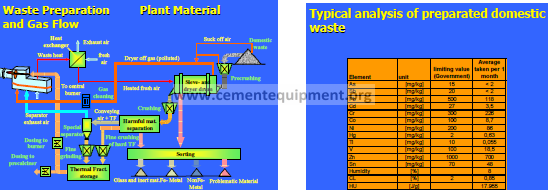
4 STORAGE, DOSING AND FEEDING OF FUELS
4.1 STORAGE
The storage condition for alternative fuels depends on the type of materials. Generally it is to take care on emissions, technical and hygienic demands.
The following examples for storage should be deemed on the conditioning site.
A Initial storage
B Intermediate storage
C Finished product storage
4.1.1 INITIAL STORAGE
A storage can be out- or inside, it depends on the delivered material. Due to logistic reasons for initial storage the area is commonly set-up directly to the conditioning plant, but depending on the type of material and preparation.
The material is supplied by truck or by railroad.
Material mix with strong contaminations (substantial biologic content) and high moisture (up to 40%) is mainly stored in special designed containers due to hygienic rules and regulations.
Animal meal has to be conditioned in absolutely closed systems. It is supplied in containers – the material can be conveyed either pneumatically or by mechanical equipment to the storage.
Liquid and slag alternative fuels (waste oil, solvent and sewage sludge) are stored in special containers. You have to elaborate special security guide lines (explosion safe, etc.)
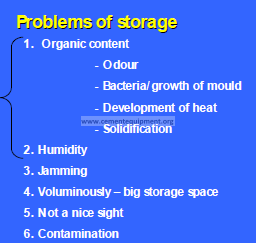
4.1.2 INTERMEDIATE STORAGE
Intermediate storage is implemented in the conditioning plant, this is to check the quality of alternative fuels after preparation process for further processing.
The intermediate storage normally is done by using some separated containers (depending on the capacity of the conditioning plant), but regarding
1 sufficient space between each conditioning step
2 storage capacity, until the labor results are set.
If the quality check gives negative results the material is hold back for the feeding to combustion. Depending on the rate of contamination, the manager in charge has to decide about further use.
4.1.3 FINISHED MATERIAL STORAGE
In the finished material (product) storage, the alternative fuels which are ready for burning, are stored. To avoid natural influence – such as humidity, moisture, even rain, etc., the material has to be covered, or to be protected preferably in some warehouse. The capacity should be calculated according to the combustion capacity and the planned shut down period.
4.2 DOSING AND FEEDING
Most important points of dosage and discharge
1.Material mixture and plastic –voluminously (ρ200kg/m3)
2.Desagglomeration
3.Piping guidance
4.Abrasive material -material choice
5.Dosage accuracy6.Constant dosage
7.Different density of the separate components -difficult discharge
8.Loading of the conveying air (kg/Am3air)9.Conveying air temperature (animal meal)
The dosing of solid alternative fuels requires materials without property of jamming content during the feeding and dosing operation. In this case moisture is the significant role.
Always keep a close look to design and construction of the feeding equipment. At pneumatic feeding it has to be assured that the conveying air capacity is as low as possible. (cooling the flame shape, NOx). Furthermore the wiring to the burner is very important as well as abrasion property of the conveyed materials has to be controlled.
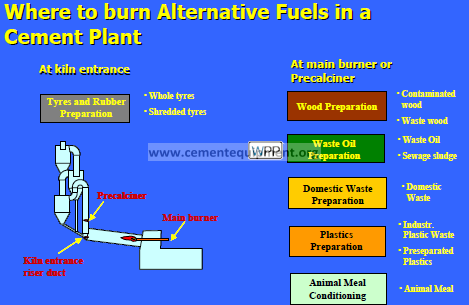
4.2.1 DOSAGE AND FEEDING OF OLD TIRES AND WOOD
The dosage of tires and contaminated wood is done by weigh-belt feeder with an exactitude of +- 1% of the determined dosing value – the value is shown on the terminal of the clinker rotary kiln. Pertinent parameters to control are temperature and the Carbon-monoxide CO-value of the combustion gas.
The feeding is commonly done with belt conveyors and weigh-belt feeder. The feed to the kiln entrance happens with double pendulum flaps or special designed dampers, to avoid fate air into the kiln system.
4.2.2 DOSAGE AND FEEDING OF PLASTIC, PAPER, TEXTILES AND MATERIAL MIX
Plastic, Paper and textiles are conveyed to the main burner either mixed or separated (primary combustion), or to the secondary combustion.
An Advantage is, that the material is conveyed from an intermediate bin over a weigh-belt feeder and rotary gate, by using compressed air, to the burner. This system is simple designed and simple to maintain. At designing you have to be aware to keep the requirement for compressed air as low as possible.
The operation of combustion is controlled as same by using conventional fuel with conventional exhaust air components.
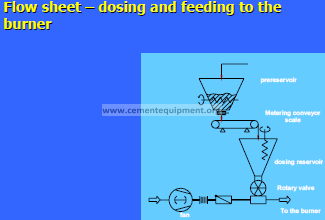
4.2.3 DOSAGE AND FEEDING OF ANIMAL MEAL
By using Animal Meal it is absolutely important to use fully closed systems to avoid emissions and to keep maintenance tasks as low.
As you can see from the image below, the animal meal gives “pressure equality”- that means that the pressure can be adjusted in the dosing box in proportion to the feeding pressure. The conveying air is cooled down to 10° C. This system is due to the possibility to adjust pressure rate low in maintenance.
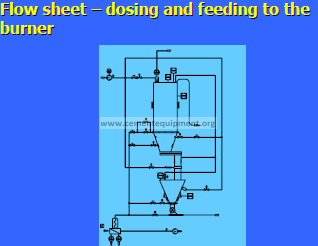
4.2.4 DOSING AND FEEDING OF LIQUID AND SLUDGE-LIKE ALTERNATIVE FUELS
This materials, prepared in the storage tank (e.g. mixed, heated), are conveyed by a dosing pump to the main burner. Safety guidelines have be insured. Flow burnerFlow sheet –dosing and feeding to the burner
5 BURNER CONCEPTION AND COMBUSTION
A most modern Multifuel- Burner has to meet specific requirements for controlling the temperature of the rotary kiln and has to guarantee a maximum of possibilities for several operating conditions.
Generally the firing has to run trouble-free, has to be operated simply and must be able to produce good clinker qualities even by using several Alternative Fuels.
This Multifuel- Burner is designed like a conventional burner, but has additional channels for Alternative Fuel and some other nozzle system.
To incinerate Alternative Fuel as well, the Alternative Fuel has to be spread as well.
Due to the “Pneumo Swirl” the Alternative Fuel comes to rotation, in order to reduce the burn-out zone.
The Alternative Fuel is provided centrally through a tube to the burner nozzle. The particles come into rotation due to tangentially aimed air jets – right before leaving the burner.
The images below show the principle of a most modern Multifuel- Burner.
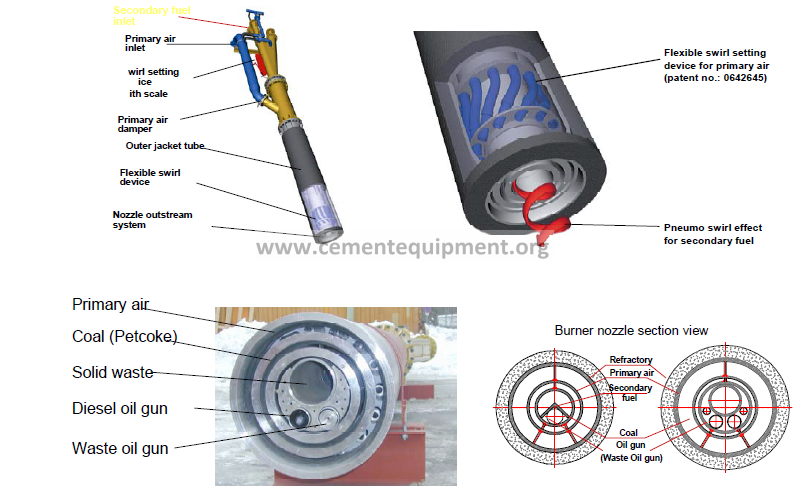
CONTROL AND ANALYZING
6.1 INITIAL CONTROL
Initial Control of Alternative Fuels is the very first step in using Alternative Fuels in order to
– achieve and guarantee legal emission limits at burning
– avoid clinker affecting vitiations as for instance Chlorine or Heavy Metals
– maintain preparation costs of Alternative Fuels as economically as well, even for elimination of non specific material
In order to share an effective Initial Control, first it is pertinent to elaborate Alternative Fuel specifications. The elaboration of that specification has to be based on internal and external terms and conditions.
External Guideline:
Enacted regulations from proper authority due to laws and some other regulation.
Internal Guideline:
Guideline for production and Quality Management according to quality management of clinker or respectively of cement, especially for instance chlorine restriction, or maybe guidelines by lobby.
That specification is specifically nationwide and can vary.
Tasks of Initial Control:
At receiving of the material on site, random samples are taken to check homogenization of material.
Mode and method of control as well as the number of random samples, the bulk in total to be analyzed, depend on the kind of fuel.
Those controls are generally to be committed and ruled with the proper authority mutually.
Type of Control System:
visual testing – based on the operators level of experience
chemical analysis
physical condition analysis
The samples are provided to the internal laboratory, while samples are held back for processing.
If the analysis show all criteria will be fulfilled, the held-back samples are forwarded to the bulk storage – either spaciously or by allocation.
If all criteria will not be fulfilled, all material will go back to the supplier who has to take all expenses for hauling.
6.2 INTERMEDIATE CONTROL
The finally prepared material as Alternative Fuel is provided to an intermediate transfer storage, where all is checked for approval – itemized every 30 ton.
In the laboratory quality criteria are checked and approved for further use as Alternative Fuel. In case of diverting results depending on impurity the person in charge has to take decision about further forwarding – either external waste or new preparation.
6.3 OVERVIEW OF ANALYZING AND LABORATORY APPARATUSES FOR QUALITY
CONTROL OF ALTERNATIVE FUELS:
The checkup of the Alternative Fuel properties within the scope of Quality Control Criteria you find beside some physical parameters, such as moisture content, calorific value and granulometric distribution and some other connoting elements approved by cement industry.
In order to fit all requests as well, the following equipment is absolutely pertinent:
– Drying closet (105°C) to dry the samples
– Checker or groomed divider (various width of gaps) to create representative sub-samples.
– Laboratory jaw crusher to prepare the finished material starting at 1 μm up to 10 μm maximum sized granules
– Vibratory disc mill for sample grinding to the degree of fineness of analysis
– Ultra-centrifugal ball mill: to crush all organic material as plastic, animal meal, wood (freeze grinding process)
– Apparatus for sampling of flue-gas, for sampling of clean gas to evaluate the chlorine and fluorine content in clinker- rotay kiln waste gas
Exploration Method:
– classic and chemical exploration method as Sadoexploration, nitrohydrochloric acid.
– Device to provide molten pearls, forward samples into a glass-matrix (Lithiumtetraborate) with X- ray fluorescence analysis
– Molding die to process briquettes out of pulverized material for X- ray fluorescence analysis
– Microwave- Exploration equipment for hard decomposing material, acidic decomposition, especially concerning heavy metals and all cations.
– Bomb- Exploration for all volatile anions.
6.3.1 CHEMICAL ANALYSIS METHOD:
– Various drying closets (40 – 250°C) to prepare samples and determine moisture content
– High output muffle furnace (500 – 1100°C) for incineration of organic samples and determination of ignition loss
– Analytical balance
– Device for providing clean water to analyze trace elements by the use of ICP
– Analyzer – mainly to support both – classic and wet-chemical methods
– PH – Ionic meter, pH value, fluorine, chlorine,
– Titroprocessor for chlorine
– Photometric apparatus to determine all methods photometrically, even for Manganese, Chrome, etc.
– CS – Analyzer for sulphur and carbon (TOC an carbon Dioxide)
– X- Ray Fluorescenic Analyzer for wide spread range of heavy metals, but so called Light-elements – starting at Hydrogen up to Oxygen. All elements, especially heavy metals within the range of 10 ppm and below sub- quantitatively.
– ICP Plasma 400 for most of all cations within a range of trace elements up to as much as approx. 1 ppm, but Thallium an Tin at limits of detection of approx. 10 ppm.
6.3.2 PHYSICAL ANALYSIS METHOD:
– Calorific Meter Gauge to determine the gross calorific value and to calculate the net calorific value automatically.
– Screen and various screen plates to determine particle distribution within the coarse of feed to screen
Primarily the following parameter of Alternative Fuels have to be analyzed:
– Moisture
– Incineration
– Lower calorific value
– Higher calorific value
– Chlorine
– Heavy metals as: Arsenic, Antimony, Lead, Cadmium, Cobalt, Nickel, Mercury, Titan, Vanadium, Zinc and Tin
7 INFLUENCE ON EMISSION
Analysis and evaluation off the influence by using Alternative Fuel on emission, on one hand we have to deem and match with balanced elements, on the other hand to consider organic trace elements within cleangas, which can result out of non- fully thermal- oxidizing destruction, caused by charged compounds within the fuel as well as created organic structures within the down cooling flue gas.
7.1 EMISSION OF BALANCE COMPLIANT ELEMENTS
Wide experience due to numerous measuring analysis have shown that metallic elements -including arsenic, but Mercury – in its emitting concentration correlates to the dustload of cleangas, where it comes to importance significantly.
Some direct influence of emitted concentration in flue gas due to Alternative Fuel can not be verified – except and only Mercury.
The emission value is generally below the enacted emission as that is defined in legal restraints or respectively defined by law nationwide.
Material- flow has to be considered for charges in secondary fuel as well as the load via raw meal (by 10 times higher mass flow).
To give evidence to that verification we have to survey the Cadmium element which is especially evaluated critically due to its volatility.
The charging into the rotarys from 50 – 70% by raw meal and approximately 30 – 50% by Alternative Fuel.
Discharging out of the system is nearly quantitatively to the separated dust (cyclone dust and precipitator dust), the cleangas emission concentration shows with and without Alternative Fuel less than 0,0001 mg/Nm³ at a cleangas dust content of less than 0,2 mg/Nm³.
Thallium, which shows properties to be compared to Cadmium – concerning volatility in thermal processing, is nearly not contained and therewith it is no emission on relevant matter.
Mercury in clinker processing is deemed as critical element due to its higher volatility.
Referring to measuring for evaluation and material flow analysis, we can conclude that the transfer turns into the dust loaded rawgas to nearly 100%, which are split to precipitator dust and to dedusted cleangas depending on temperature and process – from 40 – 60%.
A higher given factor for limitation of Hg-charging into the kiln system for this element at initial controlling, respectively the waste fraction containing higher Hg-content without additional Hg-separation referring to cleangas, can be expelled from Alternative Fuel segment.
Precise data of conditioned secondary fuel (high calorific value) shows emission concentrations from 0,003 and 0,018 mg/Nm³ – corresponding to enacted emission regulation.
Chlorine content of fuel is to be processed in the hot incineration zone – first to HCl causes with alkalis an inner concentrating circle, which can be released partly due to By-pass discharge.
The input value of Alternative Fuel gets some more important, regarding Chlorine and the accumulation of chlorine in the precipitator dust can be measured.
Due to alkali atmosphere and processing parameters it is not very likely getting HCl released to higher concentration in cleangas.
Emission concentration in bag precipitator dedusting is around 4mg HCL/Nm³, but parts of that content of Chlorine occurs as Ammonium- or Alkalichloride.
7.2 EMISSION OF NON NON BALANCED TRACE ELEMENTS – ORGANIC COMPOUNDS
Due to environment and emission especially chlorine organic compounds (such as polychloride Dibenzodioxine and Dibenzofuranes,PCDD/F) as aromatic and accordingly polyaromatic Hydocarbon (BTEX an PAH). That groups represent basically and essentially products of reactions of organic residuals within cooled off fluegas and especially at primary use of Alternative Fuel not to be seen as residuals of thermal-oxidative non fully destroyed impurities contained in fuel.
For formation of chlorine organic compounds while fluegas cooling off in clinker process, the existing condition is pretty awkward, therefore it has to be calculated with low concentration of emission in that substance group without doing some specific extra lowering process.
That has been evaluated in numerous and voluminous test series with Alternative Fuel.
The emission concentration of PCDD/F are not affected between 0,003 and 0,006 ngTE/Nm³ and in this case significantly lower than the limit of 0,1 ng TE/Nm³.
Due to exact analysis, analog assertions can be done also for polychloride Biphenyle (PCB), Polycicle aromatic hydrocarbon (PAH) and some others.
Therewith the numerous doubt is disproved that substitution of regular fuel by Alternative Fuel in primary use, especially organic emission compounds, leads to significant overrun of limits
8 INFLUENCE OF ALTERNATIVE FUEL IN CLINKER PRODUCTION
8.1 GENERAL
Alternative Fuels such as Plastic fraction potentially can contain minor traces of metal.
As shown in the figure below all potential value of major impurities of Alternative Fuel compared to standard fuels in Cement Industry.
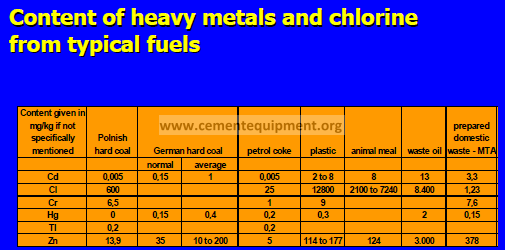
As shown in the chart above, the major impurities are mainly consisting of Heavy Metal and Chlorine.
The influence in clinker production due to that major impurities is shown as follows:
8.2 LOW VOLATILE METALS
That include metals as chrome, copper, zinc, tin, lead, nickel, arsenic, antimony, vanadium and titan.
That metals are sintered into the clinker where the embedding mainly is based upon molecular level as for instance in calcium silicate and the calcium silicate is replaced by a lead atom. That heavy metal traces which can be integrated in the clinker, are all in all at very low value, so there will not be some change in clinker mineralogy significantly.
Austria done tests and probes have shown in field tests for clinker properties with as much as 40% Alternative Fuel (thermal fractions of industrial waste) before and while feeding Alternative Fuel.
Contents of Oxide and phases in clinker do not show substantial change as shown in the chart.
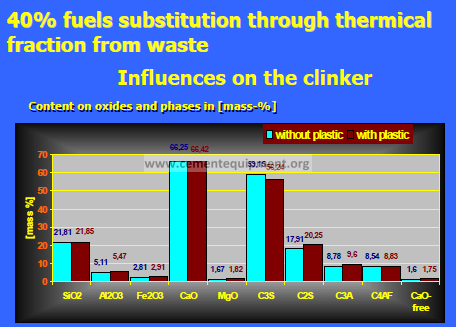
8.3 SEMI- LOW VOLATILE METHOD
Counting among such metals as: Thallium, Bismut, in several case Mercury and Cadmium.
That metals occur in the phase of gas, thereof only lowest quantities of that metal can be integrated in clinker, but condense (precipitate) at lower temperature in waste gas and are nearly separated completely in the dust filter. In that case it is substantial to assure not to proceed the filter dust on the whole to raw meal in order to avoid circles of concentration.
To damp the circle, the filter dust is conveyed to the cement grinding, where metals in cement are integrated, but in innocuous traces.
8.4 HIGH VOLATILE METALS
Alkalis react like halogen and occur gaseous. Due that case those can hardly getting integrated into clinker. Alkali- Halogens are absorbed into the raw meal in the cooler area of the kiln.
Even due this internal circulation some jeopardy of getting improved circles of Alkali Halogens.
By implementation of a By-pass system exactly these elements can be discharged and provided to some external dump.
Closing this file we conclude that the use of Alternative Fuel will give no lack in clinker mineralogy, but as known, up to now there are no affluent field test results
Me pueden compartir la información?